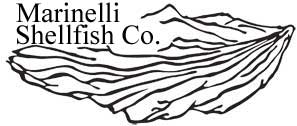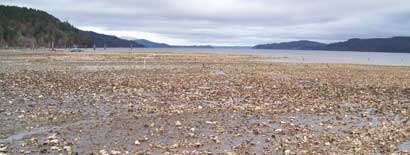Pacific Northwest Crustaceans
Select the photo to see a larger image.
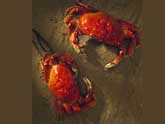
Dungeness Crab
Cancer magister
Season: Season – Year round, peaks December – April.
Dungeness crab are members of the rock crab family and take their name from the fishing village of the same name located along the Washington state side of the Straight of Juan de Fuca. They range from central California to Alaska and are caught with round steel and wire traps in depths usually ranging from 10 to 300 feet. They are the most commercially important species along the west coast except for Alaska. Fishery management regulations require a minimum shell width of 6.25 inches, and only males may be taken. Females and young males must be returned to the sea alive. Typical whole weight is usually between one to three pounds. Dungeness crab have a very high meat yield, about 25 percent, and are sold live, whole cooked, in sections, and as picked meat. Their shells turn pinkish red when cooked and the meat has an appealing sweet flavor that is very popular.
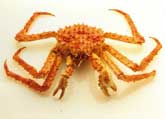
King Crab
Paralithodes camtschatica
Season: Year round frozen. Peak season November – December.
King crab is the market name for three different species of crab, although the most common of the three, and the most sought after, is the red king. In addition to the red, there are also blue (P. platypus) and brown, which are sometimes called golden (Lithodes aequspina). They range from southeast Alaska, through the Bering Sea, and down to the Sea of Japan. Harvests are restricted by quota, which are adjusted annually based on prior landings and surveys. They are caught in large wire mesh traps in depths ranging from about 400 to 600 feet. They prefer flat sandy bottoms and often travel in large groups. Typical whole weight is usually between five to ten pounds and they may grow up to seven feet from leg tip to leg tip. King crab are unique in that they have only three walking legs and two claw arms, while most species have a total of ten appendages. Most king crab is sold pre-cooked and brine frozen, although a niche market is emerging for fresh sections during the harvest season. Their shell turns bright red or orange when cooked, and the meat is sweet, firm, moist, and rich.
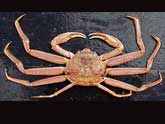
Snow Crab
Chionoecetes opilio, C. bairdi, C. tanneri, C. japonicus
Season: Year round frozen.
Peak season for C. opilio - January thru March, for C. bairdi – November.
Snow crab is the market name for four different species of crab, although the North American fishery focuses primarily on three of them, C. opilio, bairdi, and tanneri. C. bairdi comes only from Alaskan waters, C. tanneri comes only from the waters off the Atlantic coast of Canada, while C. opilio comes from both locations. C. opilio from Alaska are generally preferred over those from Northeast Canada, as they tend to have higher yield. They are caught by trap, in depths ranging from 30 to 1500 feet, on sandy bottoms. They have thin, long legs with red upper shells and tan bottom shells. They are not as large, or as red, as King crabs. Their average weight is about five pounds, while their average span is about two feet. Additionally, they have four sets of walking legs and a pair of claws, while King crab have three sets. Of the three species targeted, C. opilio makes up the majority of the fishery. Most snow crab is sold in the form of pre-cooked frozen clusters with three or four legs and a claw with the shoulder

